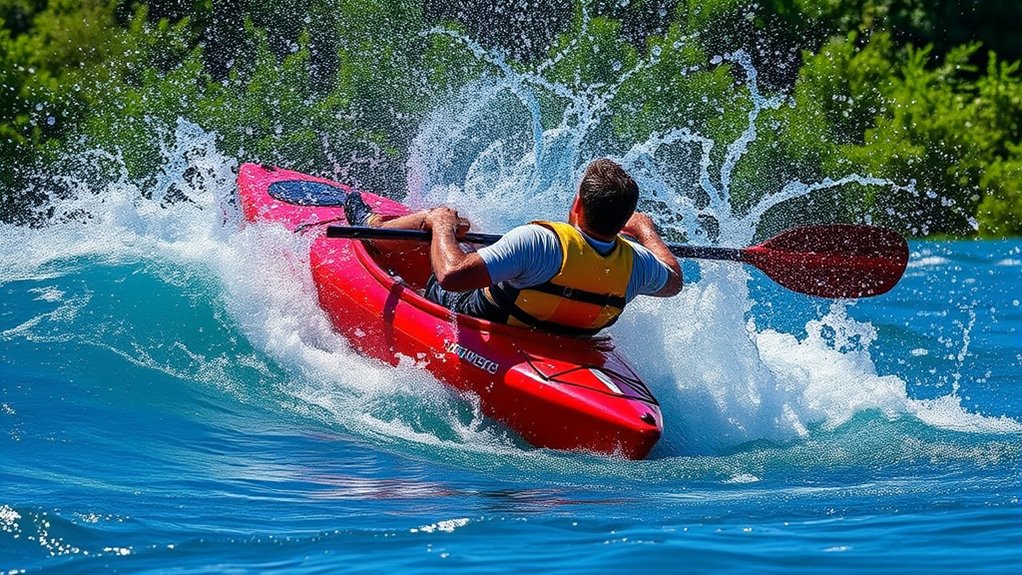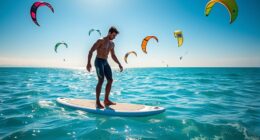In an emergency while kayaking, stay calm and assess your surroundings. If you capsize, take a deep breath and grab your paddle for stability. Swim to your kayak if it’s reachable. For self-rescue in a sit-on-top kayak, climb back on quickly while balancing your weight. In a sit-inside kayak, flip it upright and re-enter from the rear. Always wear a personal flotation device to help stay safe and conserve energy. There’s more essential information to help you prepare.
Key Takeaways
- Stay calm and assess your surroundings immediately after capsizing to make informed decisions for rescue.
- Use a personal flotation device (PFD) for buoyancy and energy conservation during self-rescue efforts.
- For sit-on-top kayaks, climb back onto the kayak quickly for stability and minimize cold water exposure.
- In sit-inside kayaks, flip it upright and use the rear for re-entry, utilizing a paddle for support.
- Regularly practice self-rescue techniques to build confidence and ensure readiness for emergencies while kayaking.

When you find yourself capsized in your kayak, knowing self-rescue techniques can mean the difference between a thrilling adventure and a dangerous situation. The moment you flip, your heart races, and your instincts kick in. You’re not just dealing with the shock of cold water; you also need to think clearly about how to get back to safety. It’s essential to remember that effective kayaking safety practices can help you navigate this scenario smoothly.
First, stay calm. Panicking can cloud your judgment and lead to poor decisions. Take a deep breath and assess your surroundings. If you’ve got your rescue equipment—like a paddle float or a bilge pump—handy, you’re already one step ahead. If you can, grab your paddle before you resurface. It’s critical for your stability once you get back in your kayak.
Once you’re back above water, look for your kayak. If it’s nearby, try to swim to it. If you can’t reach it, aim for a safe spot where you can regain your composure. The next step is to perform a self-rescue. If you’re in a sit-on-top kayak, simply climb back onto it. Use your arms to pull yourself up as you kick your legs, making sure to distribute your weight evenly. This technique is easier than it sounds and can be done in seconds.
After surfacing, locate your kayak and perform a self-rescue, climbing back on for stability and safety.
If you’re in a sit-inside kayak, the process is a bit different. You’ll want to perform a re-entry. Start by stabilizing your kayak, flipping it upright if it’s capsized. Then, climb back in from the rear. Use your paddle for support, and slide your legs into the cockpit. A paddle float can help with this process, providing additional buoyancy as you maneuver your way back in.
Don’t forget about your personal flotation device (PFD). It’s not just for show; it can greatly assist your self-rescue. If you haven’t already, secure your PFD before attempting any rescue techniques. It’ll keep you afloat and help you conserve energy while you work through the situation.
Above all, practice these self-rescue techniques before you head out on the water. Familiarity breeds confidence, and knowing you can handle a capsize will make your kayaking experience even more enjoyable. In the end, it’s all about being prepared and understanding that even in challenging situations, you have the skills to guarantee your own safety.
Frequently Asked Questions
What Gear Should I Carry for Emergency Situations in Kayaking?
You should always carry essential gear for emergencies while kayaking. Make sure you’ve got a kayak repair kit to fix any leaks or damages. Pack signaling devices like a whistle or mirror to attract attention if needed. A first aid kit is also vital for treating minor injuries. Consider a dry bag for your gear and a flashlight for visibility after dark. Staying prepared can make all the difference in an emergency.
How Can I Improve My Overall Kayaking Safety Skills?
Isn’t it better to be safe than sorry? To improve your kayaking safety skills, focus on mastering a proper paddle grip, ensuring you can maneuver effectively. Practice water entry techniques to enhance your confidence in various conditions. Regularly participate in safety workshops or courses, and consider paddling with experienced kayakers who can offer tips. Remember, the more you practice, the better prepared you’ll be for anything the water throws your way!
What Should I Do if I’m Kayaking Alone?
When you’re kayaking alone, prioritize solo safety by informing someone of your plans and expected return time. Carry essential emergency gear, like a whistle, a first aid kit, and a signaling device. Always wear a life jacket and check weather conditions before heading out. Stay within your skill level and avoid risky areas. Practice self-rescue techniques regularly, so you’re prepared if something goes wrong. Remember, being prepared can make all the difference!
Are There Any Specific Rescue Techniques for Kids?
Rescuing kids while kayaking is like steering through a tricky obstacle course—focus and preparation are key. For child-specific rescue, teach them to use kid-friendly techniques, like the buddy system and practicing capsizing drills in safe waters. If they fall out, encourage them to float on their back and signal for help. Always keep a close eye on them and make sure they wear personal flotation devices for added safety.
How Can I Stay Calm During a Kayaking Emergency?
To stay calm during a kayaking emergency, focus on mental preparedness and stress management. Take deep breaths to center yourself, and remind yourself that you’ve trained for this. Visualize a successful outcome, breaking down the situation into manageable steps. Keep your thoughts positive, and don’t hesitate to rely on your skills. Remember, staying calm helps you think clearly and react effectively, increasing your chances of a safe resolution.
Conclusion
Mastering self-rescue techniques in kayaking could be the difference between a thrilling adventure and a harrowing experience. By practicing these skills regularly, you’ll feel like a superhero, ready to tackle any emergency that comes your way. Remember, the water can be unpredictable, so staying prepared is key. Embrace the challenge, and you’ll not only enhance your safety but also boost your confidence on the water. So gear up, practice, and paddle on with peace of mind!










